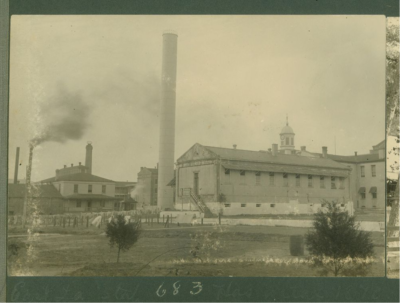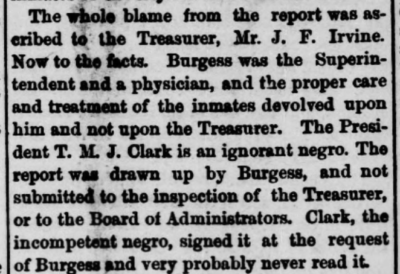Editor's Note
Today’s guest post is by William Horne, who is a Postdoctoral Fellow at Villanova University. He earned his PhD in history from George Washington University and is a founding editor of The Activist History Review.
I recently participated in a roundtable hosted by The Activist History Review with Dr. Kathleen Brian and Ayah Nuriddin examining the role eugenics plays in Republicans’ response to COVID-19. One of the interesting questions to come out of our discussion was the extent to which the state plays some role in eugenics, an issue I want to explore here by analyzing the experiences of a white doctor responding to a different sort of disease: “madness.”
Although the roles it plays might look different depending on the circumstances—enforcing anti-miscegenation laws or maintaining patterns of maldistribution—I argue that state participation is necessary for a project to be fundamentally eugenic in nature. Within the U.S. context, state power and white power are inseparable, making any eugenic project enforcing racial hierarchy a de facto state endeavor. While the state might provide potential avenues of liberation to those oppressed under imagined hierarchies of ability, the systems of oppression required to enforce these hierarchies depend on an ability to wield state power. Thus, the relationship between eugenics and the state is one that varies in form, but not in function.
Dr. Louis Burgess became superintendent of the Louisiana State Insane Asylum in 1870 at a time when doctors conceived of “madness” as rooted in race and heredity. In fact, insanity had been a whites-only affliction until emancipation, after which racial scientists began to remake race within the asylum walls. They targeted African Americans and migrants
as having innately unsound minds and prescribed a “treatment” of forced manual labor.
White supremacist agitators understood the racial implications of the asylum and forced Burgess from office in 1874 in scandal for violating medical ethics by working with the asylum’s Black president, T.M.J. Clark. This association between Burgess and Clark led the doctor to issue an apology letter as the white supremacist press to term him a “brute,” a term associated with slavery and insanity.[1] The scandal also shows that white moderates like Burgess supported early eugenics and how these moderates betrayed their Black political allies by prioritizing their commitment to racial hierarchy.

Rear view of the Louisiana State Insane Asylum taken at roughly the time Burgess and Clark served as its superintendent and president. Andrew David Lytle, “East Louisiana Hospital for the Insane, Jackson, La.,” c. 1870. Courtesy Louisiana Digital Library.
The key medical ideology at play here—what would eventually become crystallized in the eugenics movement of the late-nineteenth century—held that African Americans had some mental incapacity that justified white surveillance and coercion under slavery. Enslavement, according to the latest in enslaver science, meant that enslaved people must be exempt from insanity because they labored under white supervision without having the burden of thought. According to these medicalized practitioners of slavery, those institutionalized in the state’s asylum—almost exclusively white—might be treated for madness by forced manual labor, benefitting in the same way that Black workers benefitted from enslavement.
Emancipation upended the racist ideology of the medical establishment. Overnight, Black workers previously inoculated against madness by white direction became, according to these devotees of racial hierarchy, uniquely susceptible to its ravages.
Clark drew the ire of these white supremacist fanatics by writing a report to the Louisiana General Assembly that the white treasurer of the asylum, J.F. Irvine, had been embezzling its funds, leaving the patients without food or clothing. The racist New Orleans Bulletin initially celebrated Clark when they learned of his report on December 16, 1874, because they assumed that he was white and relished the opportunity to depict the interracial government as corrupt. This charge of interracial “corruption” formed the rationale for the White supremacist coup they had executed three months earlier that temporarily overthrew the state legislature. They hoped to justify this ethnonationalist revolt by showing the state’s interracial bureaucracy to be corrupt.[1]

The overtly racist Bulletin made clear that the new information that came to light and forced them to reassess the case was Clark’s race. “The Insane Asylum,” New Orleans Bulletin, December 22, 1874, p. 1.]
The Bulletin
changed their tune just six days later after learning, no doubt to their horror, that Clark was Black. What had initially been the heroic sacrifice of a white official became, almost overnight, an unreliable and preposterous report because the official in question, Clark, was Black. Instead, the paper alleged, there must have been a sinister plot between Clark and Burgess to malign the white treasurer of the asylum.[1]
At this point, no one disputed that money had gone missing or that the patients were on the brink of starvation. Several even died. Although supplies had been pilfered, kickbacks paid, and money embezzled, the real scandal in the eyes of the racist press was that the asylum had a Black president. Clark and Burgess resigned in disgrace, betrayed by the white legislators who had appointed them. These moderate politicians hoped to signal their commitment to racial hierarchy to retain power. Because they faced a conservative movement organized around overt white supremacy, they were unable to peel off opposition supporters and undermined the coalition of Black, Northern white, and foreign-born voters that brought the interracial government to power.
This brings us back to Burgess, who decided to blame the governor and interracial governance more broadly for the whole affair. He disparaged the Black members of the board, writing in the Bulletin that “Swazie can barely sign his name, and Hewlett is most grossly ignorant.” Burgess claimed that the governor’s appointment of “four negroes and only one white man on the board in 1873” could only have been for “political effect.” African Americans, he theorized, were simply unfit to treat the minds of the insane.[1]
So, what should we take away from Burgess’ testimony in the Bulletin
? First, eugenic theories of governance, however ill-defined, are deeply interconnected with expressions of state power. The white supremacist vigilantes understood this, and they painted all officials as prima facia corrupt and illegitimate due to membership in an interracial governing coalition. Second, Burgess was unable to rehabilitate his reputation, even after repudiating his African American colleagues. Instead, local papers termed him a “brute” long after the scandal and referred back to it as an example of the “horrors” of interracial governance into the twentieth century.
White legislators’ response to the real scandal—that a Black president and white moderate worked together—ultimately sabotaged the interracial coalition that brought them to power. This white moderate desire to defend eugenic thought and betray their own political appointees reveals a deep-seated racism that continues to undermine today’s left-leaning coalition in the Democratic Party. As the presumptive Democratic nominee, Joe Biden, appears poised to toe the line of race-baiting in his campaign to unseat a brazenly racist administration, Democrats would do well to take Burgess’ story to heart. Selling out members of a diverse political coalition fails to attract supporters of a resurgent white supremacy. In fact, as Burgess learned, it emboldens them.
[1] “The Insane Asylum Controversy; Statement of the Ex-Superintendent, Dr. L[ouis] Burgess,” New Orleans Bulletin, December 25, 1874, 5.
[1] “The Insane Asylum Controversy; Burgess Caught in His Own Trap,” New Orleans Bulletin, December 22, 1874, 1.
[1] “The Jackson Insane Asylum; How it is Conducted; The Institution Robbed By Its Officers; The Inmates Starved to Death,” New Orleans Bulletin, December 16, 1874, 2
[1] “The Insane Asylum,” The Feliciana Sentinel, August 16, 1879, 2.

0